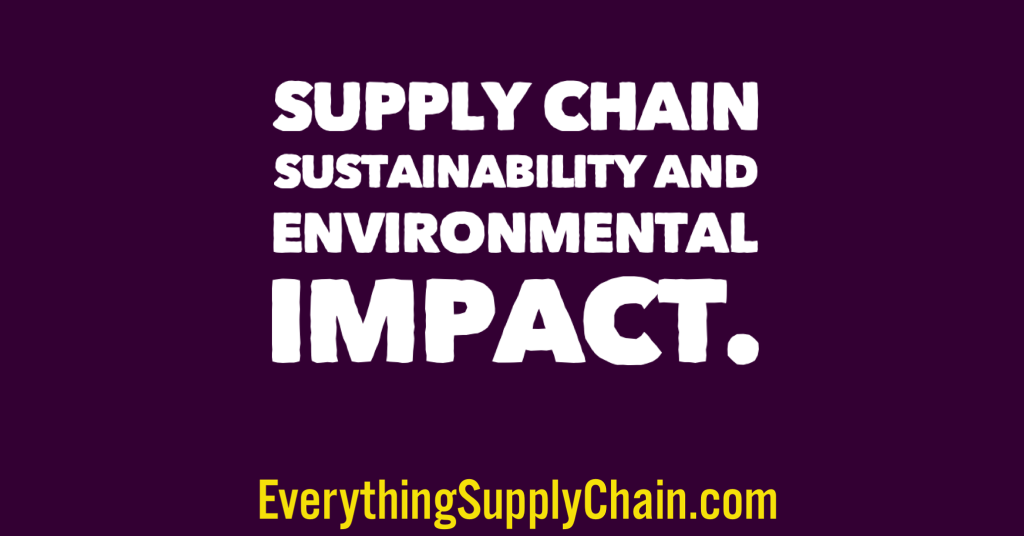Supply Chain Sustainability and Environmental Impact.
Introduction
“Creating a Sustainable Future: Optimizing Supply Chain for Maximum Environmental Impact.” Supply chain sustainability and environmental impact are two of the most important topics in the modern business world. As businesses become increasingly globalized, the need to ensure that their supply chains are sustainable and have minimal environmental impact has become increasingly important. Companies must consider the environmental impact of their supply chains, from the sourcing of raw materials to the disposal of finished products. They must also consider the social and economic impacts of their supply chains, such as labor rights, fair wages, and working conditions. By taking a holistic approach to supply chain sustainability and environmental impact, businesses can ensure that their operations are both profitable and responsible.
How Companies Can Reduce Their Carbon Footprint Through Supply Chain Sustainability
Companies can reduce their carbon footprint through supply chain sustainability by implementing a variety of strategies. First, companies should strive to reduce their energy consumption and emissions by investing in energy-efficient technologies and processes. This includes investing in renewable energy sources such as solar, wind, and geothermal, as well as utilizing energy-efficient lighting, heating, and cooling systems. Additionally, companies should consider investing in energy-efficient transportation systems, such as electric vehicles, to reduce their carbon footprint.
Second, companies should strive to reduce their waste production and emissions by investing in sustainable packaging and production processes. This includes investing in recyclable and reusable packaging materials, as well as utilizing sustainable production processes such as 3D printing and additive manufacturing. Additionally, companies should consider investing in waste management systems, such as composting and recycling, to reduce their carbon footprint.
Third, companies should strive to reduce their water consumption and emissions by investing in water-efficient technologies and processes. This includes investing in water-efficient irrigation systems, as well as utilizing water-efficient manufacturing processes. Additionally, companies should consider investing in water-efficient transportation systems, such as water-powered ships, to reduce their carbon footprint.
Finally, companies should strive to reduce their emissions from their supply chain by investing in sustainable sourcing and production processes. This includes investing in sustainable sourcing practices, such as sourcing from local suppliers, as well as utilizing sustainable production processes such as closed-loop manufacturing. Additionally, companies should consider investing in sustainable transportation systems, such as rail and sea freight, to reduce their carbon footprint.
By implementing these strategies, companies can reduce their carbon footprint through supply chain sustainability and help create a more sustainable future.
The Benefits of Implementing Sustainable Supply Chain Practices
The implementation of sustainable supply chain practices has become increasingly important in recent years, as businesses strive to reduce their environmental impact and improve their social responsibility. Sustainable supply chain practices can provide a range of benefits to businesses, including improved efficiency, cost savings, and enhanced customer loyalty.
One of the primary benefits of implementing sustainable supply chain practices is improved efficiency. By reducing waste and increasing the use of renewable resources, businesses can reduce their energy consumption and improve their operational efficiency. This can lead to cost savings, as businesses can reduce their energy costs and increase their profits. Additionally, businesses can reduce their carbon footprint by reducing their reliance on fossil fuels and increasing their use of renewable energy sources.
Another benefit of implementing sustainable supply chain practices is cost savings. By reducing waste and increasing the use of renewable resources, businesses can reduce their costs associated with production and transportation. Additionally, businesses can reduce their costs associated with packaging and shipping, as well as their costs associated with waste disposal. This can lead to significant cost savings for businesses, as they can reduce their overhead costs and increase their profits.
Finally, implementing sustainable supply chain practices can lead to enhanced customer loyalty. By demonstrating their commitment to sustainability, businesses can build trust with their customers and increase their customer loyalty. This can lead to increased sales and improved customer satisfaction, as customers are more likely to purchase from businesses that demonstrate a commitment to sustainability.
In conclusion, implementing sustainable supply chain practices can provide a range of benefits to businesses, including improved efficiency, cost savings, and enhanced customer loyalty. By reducing waste and increasing the use of renewable resources, businesses can reduce their energy consumption and improve their operational efficiency. Additionally, businesses can reduce their costs associated with production and transportation, as well as their costs associated with waste disposal. Finally, businesses can build trust with their customers and increase their customer loyalty by demonstrating their commitment to sustainability.
The Role of Technology in Achieving Supply Chain Sustainability
The role of technology in achieving supply chain sustainability is becoming increasingly important as businesses strive to reduce their environmental impact and meet the demands of a growing population. Technology can be used to improve the efficiency of supply chains, reduce waste, and increase the sustainability of operations. By leveraging technology, businesses can reduce their carbon footprint, improve their resource utilization, and create a more sustainable supply chain.
One way technology can be used to improve supply chain sustainability is through the use of data analytics. Data analytics can be used to identify inefficiencies in the supply chain and identify areas where improvements can be made. For example, data analytics can be used to identify areas where resources are being wasted, such as overproduction or inefficient transportation routes. By identifying these areas, businesses can make changes to reduce their environmental impact and improve their resource utilization.
Technology can also be used to improve the efficiency of supply chains. For example, the use of automated systems can reduce the need for manual labor, which can reduce the amount of energy and resources used in the supply chain. Automated systems can also reduce the amount of time needed to complete tasks, which can reduce the amount of energy and resources used in the supply chain. Additionally, automated systems can reduce the amount of paperwork and paperwork errors, which can reduce the amount of resources used in the supply chain.
Technology can also be used to improve the visibility of the supply chain. By using technology, businesses can track the movement of goods and materials throughout the supply chain. This can help businesses identify areas where improvements can be made, such as reducing the amount of time needed to complete tasks or reducing the amount of resources used in the supply chain. Additionally, businesses can use technology to monitor the performance of suppliers and identify areas where improvements can be made.
Finally, technology can be used to improve communication within the supply chain. By using technology, businesses can communicate more effectively with suppliers and customers, which can help reduce the amount of resources used in the supply chain. Additionally, technology can be used to facilitate collaboration between different stakeholders in the supply chain, which can help reduce the amount of resources used in the supply chain.
In conclusion, technology can play an important role in achieving supply chain sustainability. By leveraging technology, businesses can reduce their environmental impact, improve their resource utilization, and create a more sustainable supply chain. Technology can be used to improve the efficiency of supply chains, reduce waste, and increase the visibility of the supply chain. Additionally, technology can be used to improve communication within the supply chain and facilitate collaboration between different stakeholders. By using technology, businesses can create a more sustainable supply chain and reduce their environmental impact.
The Impact of Supply Chain Sustainability on Business Performance
The concept of supply chain sustainability has become increasingly important in recent years, as businesses strive to reduce their environmental impact and improve their overall performance. This paper will explore the impact of supply chain sustainability on business performance, focusing on the economic, environmental, and social aspects of sustainability.
From an economic perspective, supply chain sustainability can have a positive impact on business performance. By reducing waste and increasing efficiency, businesses can reduce their costs and increase their profits. Additionally, businesses that demonstrate a commitment to sustainability can benefit from improved customer loyalty and increased sales. Furthermore, businesses that are able to demonstrate a commitment to sustainability can benefit from improved access to capital, as investors and lenders are increasingly looking for companies that are taking steps to reduce their environmental impact.
From an environmental perspective, supply chain sustainability can have a positive impact on business performance. By reducing the use of resources, businesses can reduce their environmental footprint and improve their overall sustainability. Additionally, businesses that are able to demonstrate a commitment to sustainability can benefit from improved access to resources, as suppliers are increasingly looking for companies that are taking steps to reduce their environmental impact.
From a social perspective, supply chain sustainability can have a positive impact on business performance. By improving working conditions and providing fair wages, businesses can improve employee morale and reduce turnover. Additionally, businesses that are able to demonstrate a commitment to sustainability can benefit from improved access to talent, as job seekers are increasingly looking for companies that are taking steps to reduce their environmental impact.
In conclusion, supply chain sustainability can have a positive impact on business performance. By reducing costs, improving customer loyalty, and increasing access to resources and talent, businesses can improve their overall performance. Additionally, businesses that are able to demonstrate a commitment to sustainability can benefit from improved access to capital, resources, and talent.
The Challenges of Achieving Supply Chain Sustainability
Achieving supply chain sustainability is a complex challenge that requires a comprehensive approach. Supply chain sustainability involves the integration of environmental, social, and economic considerations into the design, management, and operation of supply chains. This requires a holistic view of the supply chain, taking into account the impacts of all activities and stakeholders involved.
The complexity of supply chain sustainability is due to the fact that it involves multiple stakeholders, including suppliers, manufacturers, distributors, retailers, and customers. Each of these stakeholders has different objectives, interests, and capabilities, which must be taken into account when designing and managing a sustainable supply chain. Additionally, supply chains are often global in nature, making it difficult to ensure that all stakeholders are working towards the same sustainability goals.
Another challenge of achieving supply chain sustainability is the need to balance short-term and long-term objectives. Companies often focus on short-term objectives such as cost reduction and efficiency, while neglecting long-term objectives such as environmental protection and social responsibility. This can lead to unsustainable practices that may have negative impacts in the long run.
Finally, supply chain sustainability requires a significant investment of resources. Companies must invest in technologies, processes, and personnel to ensure that their supply chains are sustainable. This can be a significant financial burden, particularly for small and medium-sized businesses.
In conclusion, achieving supply chain sustainability is a complex challenge that requires a comprehensive approach. It involves multiple stakeholders, balancing short-term and long-term objectives, and significant investments of resources. Companies must be willing to make the necessary investments and take a holistic view of their supply chains in order to ensure that their supply chains are sustainable.
The Role of Government in Promoting Supply Chain Sustainability
The role of government in promoting supply chain sustainability is critical. Governments have the power to create and enforce regulations that can help to ensure that businesses are operating in a sustainable manner. Governments can also provide incentives to businesses to encourage them to adopt sustainable practices.
One way that governments can promote supply chain sustainability is through the implementation of regulations. Governments can create regulations that require businesses to adhere to certain standards of sustainability. These regulations can include requirements for businesses to reduce their carbon emissions, use renewable energy sources, and reduce their waste. By creating and enforcing these regulations, governments can ensure that businesses are operating in a sustainable manner.
In addition to creating regulations, governments can also provide incentives to businesses to encourage them to adopt sustainable practices. Governments can provide tax credits or other financial incentives to businesses that are able to demonstrate that they are taking steps to reduce their environmental impact. These incentives can help to encourage businesses to invest in sustainable practices, such as using renewable energy sources or reducing their waste.
Finally, governments can also provide funding for research and development of new technologies that can help to improve the sustainability of supply chains. Governments can fund research into new technologies that can help to reduce the environmental impact of supply chains, such as new methods of transportation or new materials that can be used in the production process. By investing in research and development, governments can help to ensure that businesses are able to access the latest technologies that can help to improve the sustainability of their supply chains.
In conclusion, the role of government in promoting supply chain sustainability is critical. Governments have the power to create and enforce regulations that can help to ensure that businesses are operating in a sustainable manner. Governments can also provide incentives to businesses to encourage them to adopt sustainable practices. Finally, governments can also provide funding for research and development of new technologies that can help to improve the sustainability of supply chains. By taking these steps, governments can help to ensure that businesses are able to operate in a sustainable manner.
Conclusion
Supply chain sustainability and environmental impact are two of the most important topics of our time. As businesses become more aware of their environmental impact, they are increasingly looking for ways to reduce their carbon footprint and become more sustainable. By implementing sustainable practices throughout the supply chain, businesses can reduce their environmental impact, improve their efficiency, and create a more sustainable future.
SCM Resources
- End To End Supply Chain Management Process.
- Plastic Bottle Recycling.
- Radical Plan to End Plastic Waste.
- Scottish Company Recycles Plastic Waste Into Roads.
- Ship Breaking Yards – Where Ships Become Scrap.
- SCM Issues Impacting 2023 and Beyond.
- Supply Chain Management Key Concepts
- Supply Chain Today
- What is Return and Reverse Logistics?







































